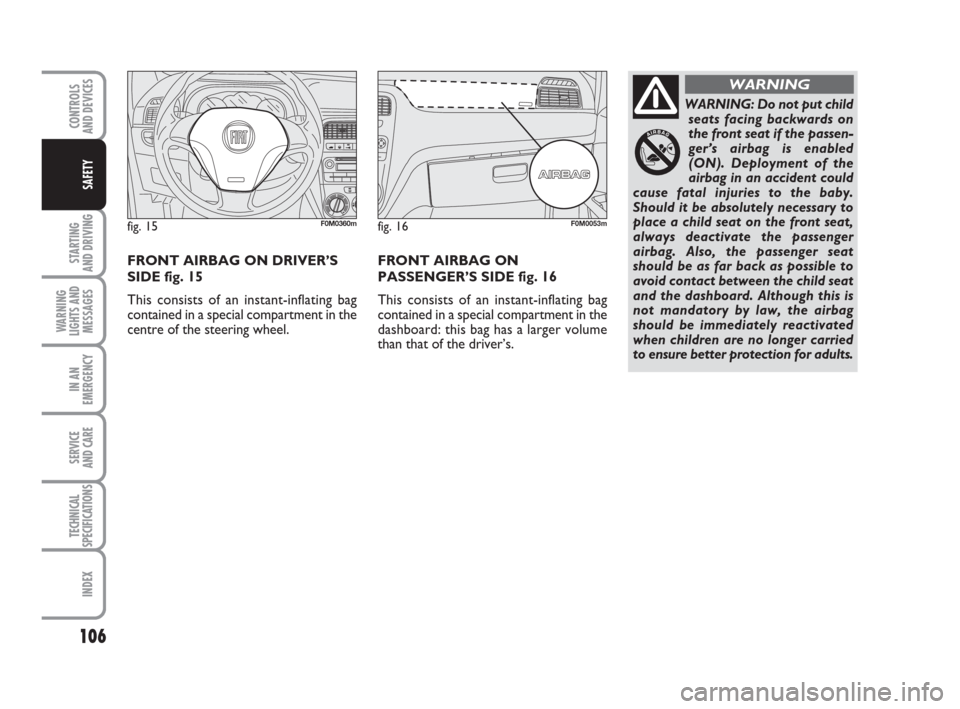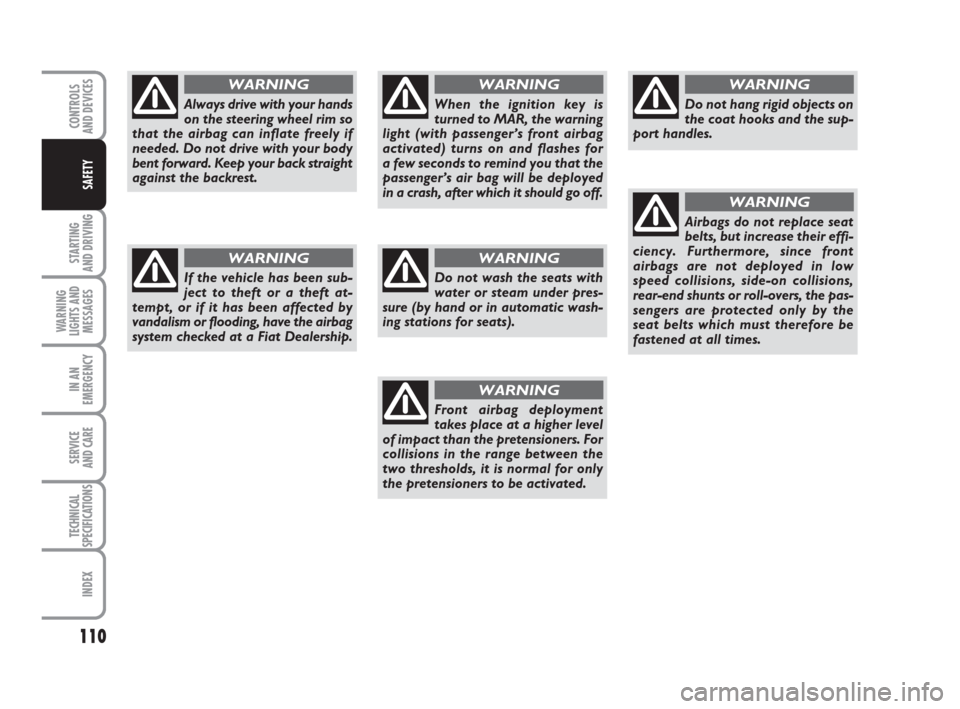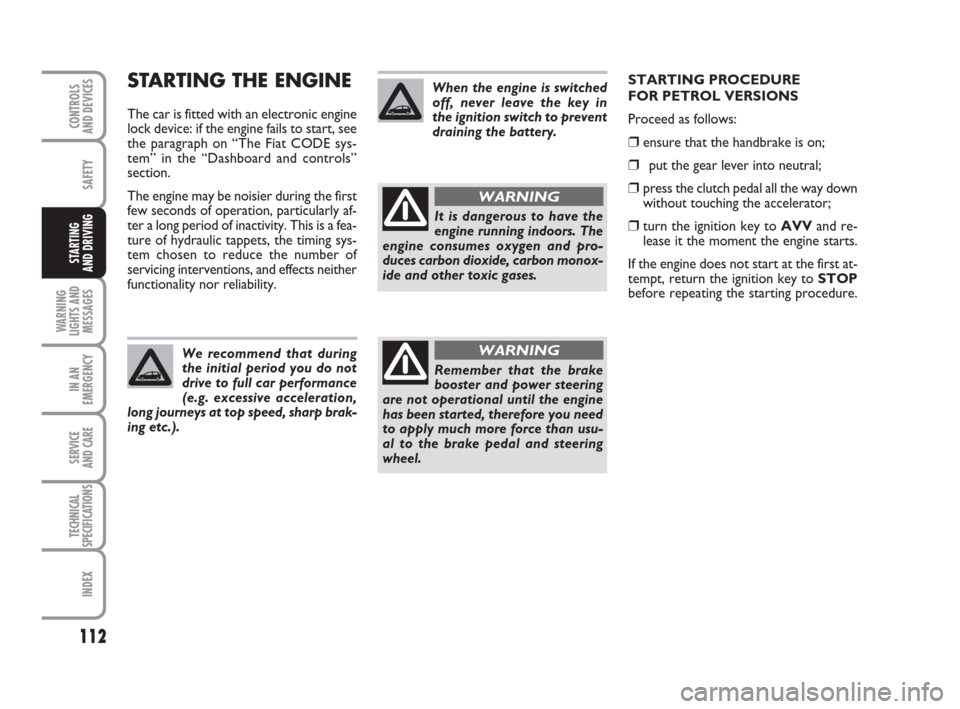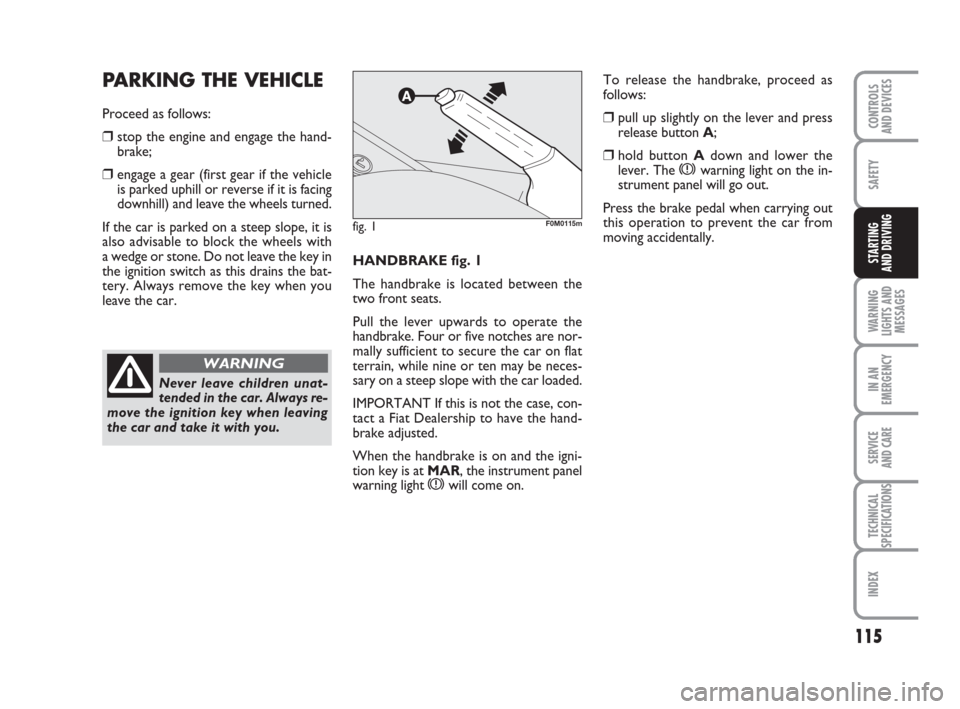2016 FIAT GRANDE PUNTO ACTUAL wheel
[x] Cancel search: wheelPage 90 of 216

89
SAFETY
STARTING
AND DRIVING
WARNING
LIGHTS AND
MESSAGES
IN AN
EMERGENCY
SERVICE
AND CARE
TECHNICAL
SPECIFICATIONS
INDEX
CONTROLS
AND DEVICES
RADIO TRANSMITTERS
ANDMOBILEPHONES
Radio transmitter equipment (vehicle mo-
bile phones, CB radios, amateur radio etc.)
shall not be used inside the car unless
a separate aerial is mounted on the roof.
IMPORTANT The use of these devices in-
side the passenger compartment (without
a separate aerial) may cause the vehicle
electrical systems to malfunction. This
could compromise safety in addition to
constituting a potential hazard for pas-
sengers’ health.
In addition, transmission and reception of
these devices may be affected by the
shielding effect of the car body.
With regard to EC-approved mobile
phones (GSM, GPRS, UMTS), you should
adhere strictly to the instructions provid-
ed by the mobile phone’s manufacturer.
Take care when fitting addi-
tional spoilers, alloy wheels
or non-standard wheel hubs: they
could reduce the ventilation of the
brakes and affect efficiency under
sharp, repeated braking or on long
descents. Make sure that nothing ob-
structs the pedals (mats, etc.)
WARNINGINSTALLING ELECTRICAL/
ELECTRONIC DEVICES
Electrical and electronic devices installed
after buying the car in the context of af-
ter-sales service must carry the following
label:
Fiat Auto S.p.A. authorises the installation
of transceiving devices provided that they
are installed by a specialised centre ac-
cording to rules of good engineering prac-
tice in compliance with the manufacturer’s
instructions.
IMPORTANT Traffic police may not al-
low the car on the road if devices have
been installed which modify the features
of the car. This may also cause invalida-
tion of warranty in relation to faults
caused by the change or either directly or
indirectly related to it.
Fiat Auto S.p.A. shall not be liable for dam-
age caused by the installation of acces-
sories either not supplied or recom-
mended by Fiat Auto S.p.A. and/or not
installed in compliance with the provided
instructions.
072-092 ACTUAL 1ed EN 26-07-2010 10:55 Pagina 89
Page 106 of 216

105
STARTING
AND DRIVING
WARNING
LIGHTS AND
MESSAGES
IN AN
EMERGENCY
SERVICE
AND CARE
TECHNICAL
SPECIFICATIONS
INDEX
CONTROLS
AND DEVICES
SAFETY
FRONT AIRBAGS
The car is fitted with front airbags for the
driver and the passenger, and with a knee
bag on the driver’s side (for versions/mar -
kets, where provided).
The front driver/passenger airbags and the
driver’s knee bag (for versions/markets,
where provided) have been designed to
protect the occupants of the front seats
in the event of head-on crashes of medi-
um/high severity, by placing the bag be-
tween the occupant and the steering
wheel or dashboard.
Non-activation in other types of crash
(side-on collisions, rear shunts, roll-overs,
etc.) is therefore not a sign of system mal-
function.
An electronic control unit causes the bag
to inflate in the event of a head-on crash.
The bag will inflate instantaneously, placing
itself between the front occupant’s body
and the structures which could cause in-
jury. It will deflate immediately afterwards.
The front driver/passenger airbags and the
driver’s knee bag (for versions/markets,
where provided) are not a replacement
for, but rather complement the use of,
seat belts, which should always be worn,
as specified by law in Europe and most
non-European countries.The volume of the front airbags at maxi-
mum inflation fills most of the space
between the steering wheel and the dri-
ver and between the dashboard and the
passenger.
In the event of an impact, someone not
wearing a seat belt will move forward and
come into contact with the bag which is
still in the opening stage. The protection
offered by the bag is reduced in such
a case.
Front airbags may not be activated in the
following situations:
❒in collisions against highly strainable ob-
jects that do not affect the front surface
of the car (e.g. bumper collision against
guard rail, piles of gravel etc.);
❒jamming of the car underneath other
vehicles or protective barriers (e.g. un-
derneath a truck or a guard rail); in this
case, the bags would offer no addition-
al protection with respect to the seat
belt and their deployment is unneces-
sary. In these cases, non-deployment of
the airbag does not necessarily indicate
a system malfunction.
Do not apply stickers or oth-
er objects on the steering
wheel, passenger side airbag cover or
upper side upholstery. Do not place
objects (e.g. mobile phones) on the
passenger side dashboard because
these could interfere with the correct
opening of the airbag and cause se-
vere injury to occupants.
WARNING
The airbags are not deployed in the event
of minor collisions (for which the with-
holding action of the seat belts is suffi-
cient). For this reason, the seat belt must
be worn at all times. In the case of side-
on collisions, the seat belts hold occupants
in the correct position and prevent them
from being thrown out of the car by a very
violent collision.
093-110 ACTUAL 1ed EN 31-08-2010 9:24 Pagina 105
Page 107 of 216

106
STARTING
AND DRIVING
WARNING
LIGHTS AND
MESSAGES
IN AN
EMERGENCY
SERVICE
AND CARE
TECHNICAL
SPECIFICATIONS
INDEX
CONTROLS
AND DEVICES
SAFETY
WARNING: Do not put child
seats facing backwards on
the front seat if the passen-
ger’s airbag is enabled
(ON). Deployment of the
airbag in an accident could
cause fatal injuries to the baby.
Should it be absolutely necessary to
place a child seat on the front seat,
always deactivate the passenger
airbag. Also, the passenger seat
should be as far back as possible to
avoid contact between the child seat
and the dashboard. Although this is
not mandatory by law, the airbag
should be immediately reactivated
when children are no longer carried
to ensure better protection for adults.
WARNING
FRONT AIRBAG ON
PASSENGER’S SIDE fig. 16
This consists of an instant-inflating bag
contained in a special compartment in the
dashboard: this bag has a larger volume
than that of the driver’s.
fig. 15F0M0360mfig. 16F0M0053m
FRONT AIRBAG ON DRIVER’S
SIDE fig. 15
This consists of an instant-inflating bag
contained in a special compartment in the
centre of the steering wheel.
093-110 ACTUAL 1ed EN 31-08-2010 9:24 Pagina 106
Page 111 of 216

110
STARTING
AND DRIVING
WARNING
LIGHTS AND
MESSAGES
IN AN
EMERGENCY
SERVICE
AND CARE
TECHNICAL
SPECIFICATIONS
INDEX
CONTROLS
AND DEVICES
SAFETY
Do not wash the seats with
water or steam under pres-
sure (by hand or in automatic wash-
ing stations for seats).
WARNING
Front airbag deployment
takes place at a higher level
of impact than the pretensioners. For
collisions in the range between the
two thresholds, it is normal for only
the pretensioners to be activated.
WARNING
Do not hang rigid objects on
the coat hooks and the sup-
port handles.
WARNING
Airbags do not replace seat
belts, but increase their effi-
ciency. Furthermore, since front
airbags are not deployed in low
speed collisions, side-on collisions,
rear-end shunts or roll-overs, the pas-
sengers are protected only by the
seat belts which must therefore be
fastened at all times.
WARNING
When the ignition key is
turned to MAR, the warning
light (with passenger’s front airbag
activated) turns on and flashes for
a few seconds to remind you that the
passenger’s air bag will be deployed
in a crash, after which it should go off.
WARNING
Always drive with your hands
on the steering wheel rim so
that the airbag can inflate freely if
needed. Do not drive with your body
bent forward. Keep your back straight
against the backrest.
WARNING
If the vehicle has been sub-
ject to theft or a theft at-
tempt, or if it has been affected by
vandalism or flooding, have the airbag
system checked at a Fiat Dealership.
WARNING
093-110 ACTUAL 1ed EN 31-08-2010 9:24 Pagina 110
Page 113 of 216

112
SAFETY
WARNING
LIGHTS AND
MESSAGES
IN AN
EMERGENCY
SERVICE
AND CARE
TECHNICAL
SPECIFICATIONS
INDEX
CONTROLS
AND DEVICES
STARTING
AND DRIVING
STARTING THE ENGINE
The car is fitted with an electronic engine
lock device: if the engine fails to start, see
the paragraph on “The Fiat CODE sys-
tem” in the “Dashboard and controls”
section.
The engine may be noisier during the first
few seconds of operation, particularly af-
ter a long period of inactivity. This is a fea-
ture of hydraulic tappets, the timing sys-
tem chosen to reduce the number of
servicing interventions, and effects neither
functionality nor reliability.
We recommend that during
the initial period you do not
drive to full car performance
(e.g. excessive acceleration,
long journeys at top speed, sharp brak-
ing etc.).
When the engine is switched
off, never leave the key in
the ignition switch to prevent
draining the battery.
It is dangerous to have the
engine running indoors. The
engine consumes oxygen and pro-
duces carbon dioxide, carbon monox-
ide and other toxic gases.
WARNING
Remember that the brake
booster and power steering
are not operational until the engine
has been started, therefore you need
to apply much more force than usu-
al to the brake pedal and steering
wheel.
WARNING
STARTING PROCEDURE
FOR PETROL VERSIONS
Proceed as follows:
❒ensure that the handbrake is on;
❒put the gear lever into neutral;
❒press the clutch pedal all the way down
without touching the accelerator;
❒turn the ignition key to AVVand re-
lease it the moment the engine starts.
If the engine does not start at the first at-
tempt, return the ignition key to STOP
before repeating the starting procedure.
111-122 ACTUAL 1ed EN 20-07-2010 16:10 Pagina 112
Page 115 of 216

114
SAFETY
WARNING
LIGHTS AND
MESSAGES
IN AN
EMERGENCY
SERVICE
AND CARE
TECHNICAL
SPECIFICATIONS
INDEX
CONTROLS
AND DEVICES
STARTING
AND DRIVING
STOPPING THE ENGINE
Turn the ignition to STOPwhile the
engine is idling.
IMPORTANT After a long drive, you
should allow the engine to “catch its
breath” before turning it off by letting it
idle to allow the temperature in the en-
gine compartment to fall.
A quick burst on the acceler-
ator before turning off the en-
gine serves absolutely no
practical purpose; it wastes
fuel and is especially damaging to tur-
bocharged engines.WARMING UP THE ENGINE
AFTER IT HAS JUST STARTED
(petrol and diesel versions)
Proceed as follows:
❒drive off slowly at medium revs, and ac-
celerate smoothly;
❒do not demand maximum performance
for the first few kilometres. Wait until
the engine coolant gauge starts moving.
Remember that the brake
booster and power steering
are not operational until the
engine has been started, so
you need to apply much more force
than usual to the brake pedal and
steering wheel.
Never jump start the engine
by pushing, towing or driving
downhill. This could cause fu-
el to flow into the catalytic
converter and damage it beyond repair.
111-122 ACTUAL 1ed EN 20-07-2010 16:10 Pagina 114
Page 116 of 216

115
SAFETY
WARNING
LIGHTS AND
MESSAGES
IN AN
EMERGENCY
SERVICE
AND CARE
TECHNICAL
SPECIFICATIONS
INDEX
CONTROLS
AND DEVICES
STARTING
AND DRIVINGHANDBRAKE fig. 1
The handbrake is located between the
two front seats.
Pull the lever upwards to operate the
handbrake. Four or five notches are nor-
mally sufficient to secure the car on flat
terrain, while nine or ten may be neces-
sary on a steep slope with the car loaded.
IMPORTANT If this is not the case, con-
tact a Fiat Dealership to have the hand-
brake adjusted.
When the handbrake is on and the igni-
tion key is at MAR, the instrument panel
warning light
xwill come on.
PARKING THE VEHICLE
Proceed as follows:
❒stop the engine and engage the hand-
brake;
❒engage a gear (first gear if the vehicle
is parked uphill or reverse if it is facing
downhill) and leave the wheels turned.
If the car is parked on a steep slope, it is
also advisable to block the wheels with
a wedge or stone. Do not leave the key in
the ignition switch as this drains the bat-
tery. Always remove the key when you
leave the car.
Never leave children unat-
tended in the car. Always re-
move the ignition key when leaving
the car and take it with you.
WARNING
fig. 1F0M0115m
To release the handbrake, proceed as
follows:
❒pull up slightly on the lever and press
release button A;
❒hold button Adown and lower the
lever. The xwarning light on the in-
strument panel will go out.
Press the brake pedal when carrying out
this operation to prevent the car from
moving accidentally.
111-122 ACTUAL 1ed EN 20-07-2010 16:10 Pagina 115
Page 122 of 216

121
SAFETY
WARNING
LIGHTS AND
MESSAGES
IN AN
EMERGENCY
SERVICE
AND CARE
TECHNICAL
SPECIFICATIONS
INDEX
CONTROLS
AND DEVICES
STARTING
AND DRIVING
IMPORTANT When snow tyres are used
with a maximum speed index below the
one that can be reached by the car (in-
creased by 5%), place a notice in the pas-
senger compartment, plainly in view, which
states the maximum permissible speed of
the snow tyres (as per an EC Directive).
All four tyres should be the same (brand
and profile) to ensure greater safety when
driving and braking as well as making the
car more responsive.
Remember that you should not change the
rotation direction of the tyres.SNOW CHAINS
The use of snow chains should be in com-
pliance with local regulations.
Snow chains may be fitted only to the
front wheel tyres (drive wheels). Use of
Lineaccessori Fiat snow chains is recom-
mended.
Check the tension of the chains after the
first few metres have been driven.
IMPORTANT When the snow chains are
on, use the accelerator with extreme
care to prevent, or to limit as much as
possible, the driving wheels from skid-
ding. This could cause the chains to
break, resulting in damage to the vehicle
body or mechanical components.
IMPORTANT Use compact 9 mm snow
chains.
SNOW TYRES
Use snow tyres of the same size as the
normal tyres provided with the car.
A Fiat Dealership will be happy to provide
advice concerning the most suitable type
of tyre for the customer’s requirements.
For the type, pressures and specifications
of the snow tyre to be used, follow care-
fully the instructions given in the “Wheels”
paragraph of the “Technical specifications”
section.
The performance of these tyres is con-
siderably reduced when the tread depth
is less than 4 mm. If this is the case, replace
them.
Due to their specific features, the perfor-
mance of snow tyres is much lower than
that of standard tyres in normal condi-
tions or on long motorway stretches. You
should therefore use them only in the
conditions for which they were designed.
The maximum speed for
snow tyres marked “Q” is
160 km/h, while it is 190 km/h for “T”
tyres and 210 km/h for “H” tyres. You
should, however, always stick to the
speed limits of the highway code.
WARNING
111-122 ACTUAL 1ed EN 20-07-2010 16:10 Pagina 121